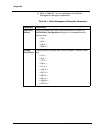
20-2
Chapter 20
Cajun P550/P880/P882 Switch User Guide
The Service Ratio can be chosen to match traffic patterns and
performance requirements using a weighted round robin scheduling
algorithm. The available service ratios of the algorithm are defined
in “Managing Buffers and Queues”. The factory default service ratio for
fabric ports is 999/1. The factory default service ratio for physical
ports is 1023 to 1. If there is traffic to be serviced from both the
high- and normal-priority queues, 999 packets of high-priority
traffic will be processed for each normal-priority packet.
When the high-priority queue fills up, incoming frames are
dropped. The philosophy is if a high-priority frame is going to be
late, it is not worth sending it at all. The normal-priority queue uses
either IEEE 802.3X PAUSE (variable timed XOFF) flow control or
Half Duplex collisions to shut off incoming frames before the queue
overflows.
The switch implements two flow control disciplines along the entire
path that frames travel. The default case is that when output buffers
fill up, frames destined for a particular buffer will be dropped. This
should only occur in a case where the output port is very congested.
However, there is an optional mode which in which normal-priority
frames are never dropped inside the switch. In this mode, input
buffers may fill up. If they do, the affected input ports may use flow
control to temporarily halt traffic from neighboring switches.
Managing Buffers and Queues
You can manage buffers and queues using either the web agent or
the CLI.
Managing
Buffers and
Queues Using
the Web Agent
To manage buffers and queues using the web agent:
1. Select Configuration from the Modules & Ports group on the
web agent window. The Module Information dialog box
opens (Figure20-1).


















